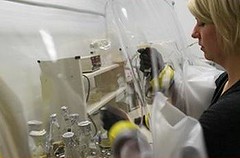 科學家在調查環境中潛在的細菌溫床時發現,號稱為「超級病菌」(superbug)的抗藥性金黃色葡萄球菌(Methicillin-resistant Staphylococcus aureus,MRSA,亦稱抗甲氧西林金黃色葡萄球菌)盛行於美國數個污水處理廠中。
科學家在調查環境中潛在的細菌溫床時發現,號稱為「超級病菌」(superbug)的抗藥性金黃色葡萄球菌(Methicillin-resistant Staphylococcus aureus,MRSA,亦稱抗甲氧西林金黃色葡萄球菌)盛行於美國數個污水處理廠中。
眾所皆知,由MRSA所產生的細菌性感染,會對醫院病患造成難以治療的傷害並可能有致命的風險。而至1990年代末期,除了身體健康的人之外,其他人在社區環境中亦有可能受到感染。
該研究負責人,馬里蘭大學應用環境健康學院助理教授Amy Sapkota表示,MRSA的感染事件開始在醫院以外的地方發生,稱為社區性MRSA(community-acquired MRSA,CA-MRSA),其發生數量正在增加,而且和醫院感染MRSA (Hospital-associated MRSA)一樣危險。
Sapkota表示,「但我們仍不能完全了解MRSA在環境中的潛在來源,或社區中的人們如何接觸到這種微生物。」
該研究指出,污水處理廠的工作人員以及其他在污水處理廠附近居住、工作和遊憩的人們,都有可能接觸到這些超級病菌。
由於受MRSA感染的人可能從他們的鼻孔、皮膚或是透過排泄物散播病原,使得污水處理廠可能成為該病原的溫床。
瑞典的研究人員已經確認有MRSA存在瑞典污水處理廠中,而這一新的研究證實了MRSA在美國污水處理場中同樣存在。
該研究團隊,包括馬里蘭大學公共衛生學院與內布拉斯加大學醫學中心的科學家。他們採集了兩個中大西洋地區(Mid-Atlantic)與兩個中西部污水處理廠處理過程中的污水樣本進行研究。
選擇這些污水廠的部份原因,是由於這些污水廠會將處理過程中產生的污水重複使用,進行灌溉工作。研究人員想知道,MRSA是否仍然存在於這些再生水中。
研究發現,MRSA與其相關的病原體:甲氧西林敏感金黃色葡萄球菌 (methicillin-susceptible Staphylococcus aureus, MSSA),在四個污水處理廠都有:一半的樣本中有MRSA存在,而MSSA出現率則有55%。
所有污水處理廠中有83%未經處理的污水含有MRSA。但MRSA與MSSA的出現率皆會隨污水處理過程而下降。
只有一個污水處理廠在處理過後的水中仍含有病原體。該場並沒有定期進行加氯消毒(chlorination)的步驟,也就是污水處理的第三階段。
93%的MRSA菌株會從廢水中被分離出來,而29%的MSSA菌株可以耐受兩種或兩種以上的抗生素,其中包括一些美國食品藥物管理局(FDA)特別指示可用於處理MRSA感染的藥劑。
兩個污水處理廠中,隨著污水處理步驟的進行,MRSA菌株表現出更強的抗藥性,且由基因調控造成的致病性也越高,直到出現第三階段的氯化處理,除去了所有MRSA。
這顯示,污水處理廠想要有效減少MRSA和MSSA的同時,可能導致其抗藥性與致病毒性的增加,特別是那些不採用第三階段加氯處理的污水廠。
公共衛生學院博士生既本研究首要作者Rosenberg Goldstein呼籲,未來研究應進一步了解在以再生水灌溉的農業與休閒用地,以及在其附近工作、遊憩或居住人群的風險。他表示,「由於有越來越多使用再生水的情況,因此我們需要進一步評估接觸再生水中所含抗藥性病菌的風險。」
污水處理廠工作人員透過經常洗手及使用手套即可以降低風險;而使用通過三級處理的再生水進行灌溉亦然。
這項研究發表於11月份《環境與健康展望期刊》(Environmental Health Perspectives) ,由美國國家環境健康科學研究院所出版。
The “superbug” methicillin-resistant Staphylococcus aureus, or MRSA, is prevalent at several U.S. wastewater treatment plants, scientists have found in the first study to investigate U.S. wastewater as an environmental reservoir of the bacteria.
MRSA is well known for causing bacterial infections that are difficult to treat and potentially fatal in hospital patients. Since the late 1990s it also has been infecting otherwise healthy people in community settings.
“MRSA infections acquired outside of hospital settings – known as community-acquired MRSA or CA-MRSA – are on the rise and can be just as severe as hospital-acquired MRSA,” says research study leader Amy Sapkota, assistant professor in the Maryland Institute for Applied Environmental Health.
“However, we still do not fully understand the potential environmental sources of MRSA or how people in the community come in contact with this microorganism,” Sapkota said.
The study indicates that wastewater treatment plant workers and anyone who lives, works or plays near wastewater treatment plants could be exposed to these superbugs.
Because infected people can shed MRSA from their nostrils and skin and through their feces, wastewater treatment plants are a likely reservoir for the bacteria.
Swedish researchers have identified the presence of MRSA in wastewater treatment plants in Sweden, and this new study confirms the presence of MRSA in U.S. facilities.
The research team, including scientists from the University of Maryland School of Public Health and the University of Nebraska Medical Center, collected wastewater samples throughout the treatment process at two Mid-Atlantic and two Midwestern wastewater treatment plants.
These plants were chosen, in part, because treated effluent discharged from these plants is reused as reclaimed wastewater in spray irrigation activities. The researchers were interested in whether MRSA remained in the effluent.
They found that MRSA, as well as a related pathogen, methicillin-susceptible Staphylococcus aureus, or MSSA, were present at all four wastewater treatment plants, with MRSA in half of all samples and MSSA in 55 percent of the samples.
MRSA was present in 83 percent of the influent – the raw sewage – at all plants, but the percentage of MRSA-and MSSA-positive samples decreased as treatment progressed.
Only one wastewater treatment plant had the bacteria in the treated water leaving the plant, and this was at a plant that does not regularly use chlorination, a tertiary step in wastewater treatment.
Ninety-three percent of the MRSA strains that were isolated from the wastewater and 29 percent of MSSA strains were resistant to two or more classes of antibiotics, including several that the U.S. Food and Drug Administration has specifically approved for treating MRSA infections.
At two wastewater treatment plants, MRSA strains showed resistance to more antibiotics and greater prevalence of a gene associated with virulence at subsequent treatment stages, until tertiary chlorination treatment appeared to eliminate all MRSA.
This suggests that while wastewater treatment plants effectively reduce MRSA and MSSA from influent to effluent, they may select for increased antibiotic resistance and virulence, particularly at those facilities that do not employ tertiary treatment with chlorination.
Rosenberg Goldstein is calling for further research to determine the extent of risk to people who work, play or reside near agricultural and recreational land irrigated with reclaimed wastewater, saying, “Because of increasing use of reclaimed wastewater, further study is needed to evaluate the risk of exposure to antibiotic-resistant bacteria in treated wastewater.”
Frequent hand washing and the use of gloves by wastewater treatment plants workers could reduce risk and through tertiary treatment of wastewater that is to be used for irrigation.
The study is published in the November issue of the journal “Environmental Health Perspectives,” a publication of the U.S. National Institute of Environmental Health Sciences.
※ 全文及圖片詳見:ENS

